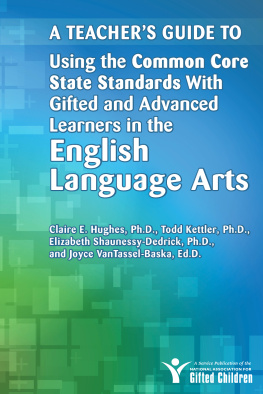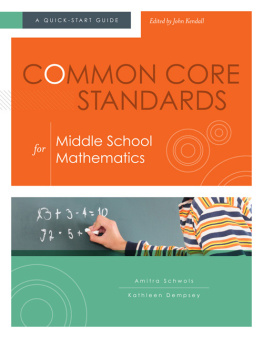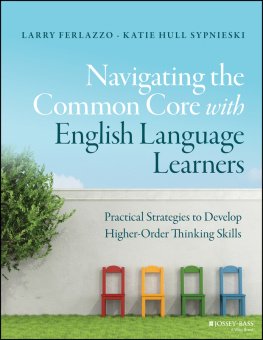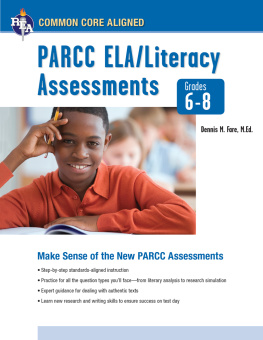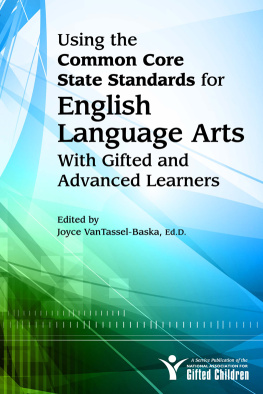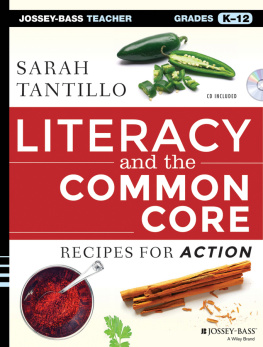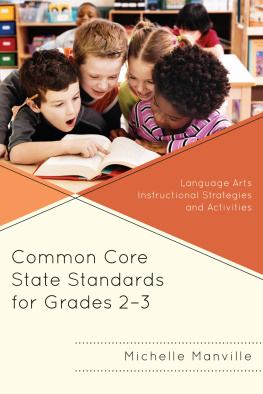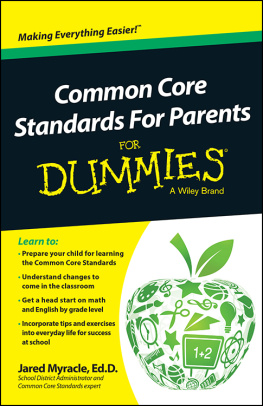ACKNOWLEDGMENTS
I wish to thank my editor, Tom Koerner, for his support and guidance during my work on this book. He was generous with his time, talent, and patience as I worked from concept to finished manuscript. His assistant, Carlie Wall, has been an important support to me during this process.
In addition, I would like to acknowledge the help I have received on the content of this book. My husband, Steve Porton, reviewed the chapter on math. Barbara Leonard reviewed the chapter on history/social studies. Mary Ann Crimi read the chapters on E/LA. Karen Cifranick helped me with the chapter on science. Everyone needs a peer editor, and I am grateful to all of mine.
I have been blessed with a large and loving family. My family of origin, Bob Dorfman, Susan Levin, and Lucille Karr, are always there to support my efforts. My own children, Debbie Watson and David Schwartz, keep me grounded and happy. My extended family of Jeff and Wendy Porton and Susie and Matt Neuberger has added much joy and richness to my life. In addition, my Duffy clan of Trisha and Mike Swam, Cyndi and Joe Tirone, Bill Duffy, and Tim and Claudia Duffy remind me constantly of what makes a real family. And of course, my writing companion, HRH Lilly R. Porton, is a constant source of unconditional love.
Writing can be a lonely and stressful occupation for me. I could not accomplish my goals without the love and support of my family and friends. I am blessed to have both.
ADDITIONAL REFERENCES
Baird, J. R., Fensham, P. J., Gunstone, R. T., & White, R. T. (2006). The importance of reflection in improving science teaching and learning. Journal of Research in Science Teaching, 28(2), 163182.
Crawford, J. (2012). Aligning your curriculum to the Common Core State Standards. Thousand Oaks, CA: Corwin.
David, L. (2012). 5 things every teacher should be doing to meet the Common Core State Standards. Eye on Education. www.eyeoneducation.com.
Dunkle, C. A. (2012). Leading the Common Core State Standards. Thousand Oaks, CA: Corwin.
Forty-Nine States and Territories Join Common Core State Standards Initiative (2009). www.nga.org/cms/home/news-room/news-releases/page_2009/col2-content/main.
Foster, V. A., & McAdams, C. R. (2009). A framework for creating a climate of transparency for professional performance assessment: Fostering student investment in gatekeeping. Counselor Education and Supervision, 48(4), 271284.
Jago, C. (2011). With rigor for all: Meeting Common Core Standards for reading literature (2nd ed.). Portsmouth, NH: Heinemann.
McNulty, R. J., & Gloecker, L. C. (2011). Fewer, clearer, higher Common Core State Standards: Implications for students receiving special education services. International Center for Leadership in Education (February).
McTighe, J., & Wiggins, G. (2013). Essential questions: Opening doors to student understanding. Alexandria, VA: ASCD.
STRUGGLING LEARNERS AND COMMON CORE STATE STANDARDS
Every student can learn, just not on the same day, or the same way.
George Evans
D uring the past year, the number of books and chapters written about the Common Core State Standards (CCSS) has increased dramatically. As a result, it has become increasingly clear that students who struggle to learn the current statewide curriculum will require additional support in order to obtain the higher-order thinking skills required by CCSS.
The purpose of this book is to bridge the gap between policy initiatives such as the Common Core and the implementation of these standards when teaching English/language arts, mathematics, social studies, and science to struggling learners.
In this book, struggling learners are defined as follows: (1) students who have an external locus of control; (2) students who are unsuccessful at meeting appropriate grade-level requirements; (3) students who come from marginalized homes and/or communities where the issues at home or in the broader community affect the childs performance in school; and (4) students who have a limited and/or grim notion of the future (Porton, 2013).
IN THIS CHAPTER
The purpose of this chapter is to lay out the history of CCSS, especially in terms of struggling learners. When faced with obstacles as impressive as those faced by struggling learners, it is natural to look into the literature to see what techniques have demonstrated success in the past with this population.
Many teachers have taught struggling learners using cooperative learning strategies and found it to be an effective methodology for teaching and learning. It is an effective system for encouraging peer support, developing connections, and improving work habits.
Since most practitioners want to know how to translate theory into practice, a broad overview of CCSS unit and lesson plans will be provided. Because many struggling learners have displayed a failure to thrive in school syndrome, the Habits of Mind procedures for teaching and learning will be reviewed. This model explicitly teaches those skills and behaviors that successful students have internalized and can access easily. Struggling learners, however, are noted for their lack of proficiency with these habits. Finally, an authentic look at differentiation and its utility with this population will be provided.
COMMON CORE STATE STANDARDS
In 1983, when A Nation at Risk was released, the government was convinced it had found both the source and the cure for Americas poor standing in academic achievement and students preparation for post high school success. Over twenty-nine years later, Americas schools are still struggling with the same issues. For example, according to the ACT College Readiness report, 78 percent of high school graduates did not meet the readiness benchmark levels for one or more entry-level college courses in mathematics, science, reading, and English (Members of the 2005 Rising above the Gathering Storm Committee, 2010, p. 11).
The National Governors Association felt so strongly about the depth and breadth of this problem, it worked with the Council of Chief State School Officers to create a common core of state standards. Common standards that allow us to internationally benchmark our students performance with other top countries have the potential to bring about a real and meaningful transformation of our education system to the benefit of all Americans (National Governors Association, 2012, as cited in Common Core State Standards Initiative, p. 1).
Prior to the development of CCSS, American schools functioned under the guidelines set by No Child Left Behind (NCLB). Nevertheless, as long as the standards described and the assessments created as a result of No Child Left Behind only required students to read, recall, and recite, students ability to create in-depth analyses and interpretations of informative and fictional texts and demonstrate genuine understanding of mathematical principles were unlikely results of standard teaching practices.
During the same time period that the CCSS was being developed, the presidents of the National Academy of Sciences, National Academy of Engineering, and Institute of Medicine were asked to respond to a request made by a bipartisan group of senators and members of Congress and find answers to these questions:
What are the top 10 actions, in priority order, that federal policymakers could take to enhance the science and technology enterprise so that the United States can successfully compete, prosper, and be secure in the global community of the 21st century? What strategy, with several concrete steps, could be used to implement each of those actions? (Bingaman & Alexander, as cited in


